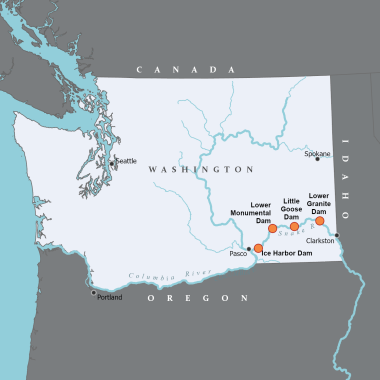Planning study news
The study is organized into four phases.
Phase 1 – Understanding Needs
Phase 2 – Impacts and Safety
Phase 3 – Competitive and Regulatory Impacts
Phase 4 – Draft and Final Report
Phase 1 of the study, Understanding Needs, was completed in spring of 2025, with a status report released in December 2024 (see “Outcomes” tab below for the report). The report includes an analysis of existing goods movement conditions, existing volumes, rail and vehicular volume changes.
During Phase 1, the project team began collecting information from companies that create and move freight to be able to build a transportation model. The transportation model is being used throughout the study to determine how the transportation network will need to change to continue moving goods into and out of Eastern Washington.
The study is currently in Phase 2, Impacts and Safety, which began in winter of 2025. Phase 2 will develop scenarios to try and understand what will happen to the rail and road network should the dams be removed and look for ways to help mitigate the impacts. This phase involves an estimation of geological, geographical, rail, road, and utility impacts from dam closure as well as a safety analysis and a broad public engagement effort will accompany it.
Phase 3 will begin in Summer 2025 and will identify potential mitigation options for impacts as well as estimate the competitive impacts of modal diversion.
The study team formed two advisory committees: the Technical Advisory Committee and the Community Advisory Committee. These groups meet at key milestones throughout the study to provide additional review and input for data analysis and community engagement.
Technical Advisory Committee
The Technical Advisory Committee is charged with reviewing study elements and representing their organization/agencies interests. Their primary role is to ensure that the study is using the most up to date local, regional and state data. This includes keeping agency partners informed about technical and policy work and helping the project team understand local, regional, state and tribal needs. The Technical Advisory Committee is comprised of representatives from various organizations, federal, state and local representatives, and businesses.
Community Advisory Committee
The Community Advisory Committee is charged with representing organizational and governmental interests and reviewing community engagement approaches within the study. Their primary role is to ensure that the study considers the direction of current local policy and maintains strong community engagement and outreach. This includes keeping local organizational stakeholders and government offices informed about the study and engagement opportunities, as well as helping the project team understand local, regional, state and tribal needs. The committee is comprised of representatives from various local organizations and local elected officials.
Purpose
The Snake River from Clarkston to Pasco contains four dams (Ice Harbor, Lower Monumental, Little Goose and Lower Granite). There has been much interest in removal of these dams for the benefit of salmon, steelhead, Pacific lamprey, bull trout, sturgeon and other native fish species. While there have been several studies that address the topic of removing the dams, there is limited understanding of how transportation would be affected.
As such, the Legislature (see ESHB 2134, Section 217 (9)) directed WSDOT to conduct an analysis of highway, road and freight rail transportation needs, options and impacts of shifting the movement of freight and goods that currently move by barge to truck and rail. This study will fulfill that request by the Legislature.
Upcoming engagement opportunities
To stay up-to-date, join GovDelivery and check out the public engagement calendar of events (PDF 188KB).
Quarterly reports and other resources can be found in the Outcomes tab below.
Recent studies by the U.S. Army Corps of Engineers, Bureau of Reclamation, and Bonneville Power Administration (July 2020) and another by National Oceanographic and Atmospheric Administration (NOAA) National Marine Fisheries Service (September 2022), explored in detail the benefits and drawbacks of many aspects of removing the lower Snake River dams. While the Corps study did investigate the transportation impacts (see the Transportation discussion under MO3), the NOAA study did not.
Because the transportation impacts of removing the lower Snake River dams were not sufficiently addressed in those prior studies, the Legislature directed WSDOT to conduct an analysis of highway, road and freight rail transportation needs, options and impacts from shifting the movement of freight and goods that currently move by barge through the lower Snake River dams to highways, other roads and rail.
The study should generate volume estimates and evaluate scenarios for changes in infrastructure and operations that would be necessary to address those additional volumes. The assessment must include quantitative analysis based on available data in terms of both financial and carbon emission costs. The analysis must also include a robust inclusive public engagement process to solicit feedback from interested community members.

